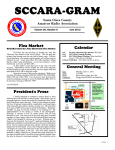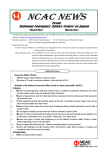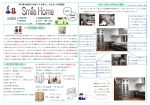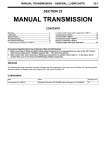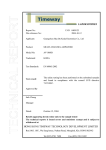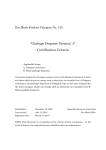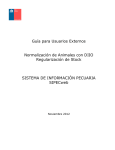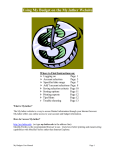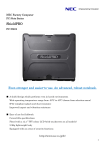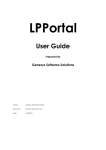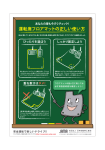Download NCAC NEWS(Vol.23,No.6)
Transcript
NCAC NEWS From National Consumer Affairs Center of Japan Vol.23 No.6 * March 2012 For further details regarding each topic introduced below, refer to the following URL which contains the actual text of the reports released (PDF files) (Japanese only):http://www.kokusen.go.jp/news/news.html -Inside of this issue- I. Consumer Affairs Climate P1 1. 39th Survey of Trends in People's Livelihood: Findings and Summary Responding to Dangers in and Safety from Daily Surroundings http://www.kokusen.go.jp/pdf/n-20111201_1.pdf P2 2. Ten Major Topics for 2011 related to Consumer Affairs http://www.kokusen.go.jp/pdf/n-20111208_2.pdf II. National Consumer Affairs Center of Japan(NCAC)Activities P3 1. Overpriced Charges by Unscrupulous "Dating Sites": Exchanging Email on Sites that Lure People with the Promise of Earnings P4 P6 P7 P8 http://www.kokusen.go.jp/pdf/n-20111201_3_1.pdf 2. Troubles Accompanying the Rapid Rise of Smartphones http://www.kokusen.go.jp/pdf/n-20111201_2.pdf 3. Be Careful Using Household Power Tools!: Accidents Include Severed Fingers and Internal Organ Injury http://www.kokusen.go.jp/pdf/n-20111208_1.pdf 4. Issues with Dental Implants: Physical Health Problems http://www.kokusen.go.jp/pdf/n-20111222_2.pdf 5. Performance of Relatively Inexpensive Radiation Meters: Round 2 http://www.kokusen.go.jp/pdf/n-20111222_1.pdf * Major abbreviated names: ADR: Alternative Dispute Resolution NCAC: National Consumer Affairs Center of Japan PIO-NET: Practical Living Information Online Network System I. Consumer Affairs Climate 1. 39th Survey of Trends in People's Livelihood: Findings and Summary Responding to Dangers in and Safety from Daily Surroundings The National Consumer Affairs Center of Japan(NCAC)conducted its ‘39th Survey of Trends in People's Livelihood’ from May to June 2011. Since 1971, this survey has sought to understand the environment surrounding consumers and changes in consumer awareness by surveying "product and service dissatisfaction and harm, and measures being taken to 1 address them," as well as by surveying the circumstances of issues and social concerns for which the Center receives many consumer inquiries. Under the topic of "Responding to Dangers in and Safety from Daily Surroundings," the NCAC has compiled survey findings for the year prior to the Great East Japan Earthquake regarding "awareness of consumer warnings," "solicitations from unscrupulous businesses," and "coping with problem products in the house." The following summarizes the findings: (1) The year prior to the disaster: Dissatisfaction and Harm from Purchased Products and Services, Awareness of the NCAC and Local Consumer Centers as well as Consumer-related Laws. a) The number of people experiencing dissatisfaction and/or harm from purchased products and/or utilized services was 33.1%. Of these, 58.3% had somewhere made inquiries or communicated their complaints. b) The number of people aware of the NCAC or their local consumer center was 80.8%. Of these, 9.4% had used them. The top reason (59.8%) for using centers was to "consult about complaints." c) The number of people aware of "cooling off" was 85.8%. Around 10% were aware of the Consumer Contract Act and Consumer Basic Act. (2) The year prior to the disaster: Responding to Dangers in and Safety from Daily Surroundings a) The number of people aware of "consumer warnings (i.e. warnings issued by NCAC, local consumer centers, etc.)" regarding troubling commercial practices and/or unscrupulous businesses was 60.7%. These warnings were considered "useful" by 90.2%. b) The number of people solicited through troubling commercial practices and/or by unscrupulous businesses was 28.4%. Of these, 42.0% took countermeasures, including making inquiries. c) The number of people aware of food recall notices was 65.0%. Of these, 4.4% had problem (recalled) foods in their houses. The number who responded to recall notices was 86.7%. d) The number of people aware of product recall notices was 73.0%. Of these, 16.4% had problem (recalled) products in their houses. The number who responded to recall notices was 89.2%. 2. Ten Major Topics for 2011 related to Consumer Affairs The NCAC has compiled and published a list of the "Ten Major Topics related to Consumer Affairs" for that year based on the many consumer inquiries received and on items that drew social attention during the year as issues of consumer concern. In 2011, consumers encountered various problems in connection with the Great East Japan Earthquake that occurred on March 11. Debate over the role of NCAC also became an occasion to draw attention to the role of consumer affairs administration. ○ Ten Major Topics for 2011 related to Consumer Affairs ・ The Great East Japan Earthquake. Received numerous related inquiries ・ Widespread anxiety regarding radioactive substances ・ Relentless stream of "theatrical" solicitations (with offers from "buyers") ・ Bankruptcy of Agura Bokujo, which operated a Wagyu cattle-raring business ・ Wheat allergies, including unconsciousness caused by former Cha no Shizuku soap ・ Group food poisoning resulted from yukke (raw beef) ・ Numerous Japanese Supreme Court rulings made regarding rental housing ・ In line with regulatory streamlining, regulations were strengthened against unscrupulous apartment solicitations and door-to-door precious-metal buyers 2 ・ The introduction of collective consumer redress for damages and other such institutions that protect consumer interests continues to be studied ・ Reexamination of the NCAC's role continues to be discussed II. National Consumer Affairs Center of Japan(NCAC)Activities 1. Overpriced Charges by Unscrupulous "Dating Sites": Exchanging Email on Sites that Lure People with the Promise of Earnings Overview of Inquiries In recent years, local consumer centers around Japan have continued to receive inquiries (some 30,000 cases annually) regarding "dating sites." Their methods have become increasingly clever and their charges are increasingly high. Advertising, banners, and spam are sometimes problematic in the many inquiries received regarding "dating sites," but what is most important when it comes to avoiding trouble is for consumers to exercise sufficient caution. Also noteworthy is the sudden increase in inquiries regarding sites that lure visitors interested in earning money (inquiries regarding "dating sites" included people whose intention was to use the site to earn money because it said they could "receive money" or "earn income," but who instead had problems because they were charged fees for using the site). The number of such inquiries in 2010 was double that of 2009. (Graph 1) <Graph 1> Number of Inquiries Related to "Dating Sites" 6000 5000 4000 3000 2000 1000 0 40000 5371 34925 32190 24059 285 33484 2580 651 30000 28491 2766 1189 20000 10000 0 FY2006 FY2007 FY2008 Lured by earnings FY2009 FY2010 FY2011 All inquiries related to "dating sites" Example Cases of Inquiries & Complaints Case 1: I registered with the site after receiving an email telling me I could exchange addresses with high-income earners. Next, I got an email saying I could receive 8,000,000 yen in assistance. To receive the assistance, I then transferred several thousand yen as handling charge, after which I was charged tens of thousands of yen. Over the course of three days, I ended up transferring about 1,800,000 but never received any income. (Inquiry from a woman in her 30s) Case 2: When I was using my mobile to search for information on part-time work, I was shown an at-home job "for anyone with a mobile and just thirty minutes a day" and sent a blank email in response. Next, I got an email saying they would transfer 8,000,000 yen to me if I would be a conversation partner. I assumed this was the job shown me 3 by the part-time work site and paid the several thousand yen required to receive the money. After that, I was charged tens of thousands of yen for various reasons. I ended up paying with my credit card, but never received any income. (Inquiry from a woman in her 20s) Case 3: I live alone and was having a hard time paying bills. This is when I got an email on my mobile from someone offering to pay me money for listening to their troubles. When I revealed that my parents were hurting for money after the disaster, the person said they would assist me with 300,000 yen. All I needed to do was following the instructions on the website to receive the money. Next, I got an email from someone identifying himself as a banker who told me he was holding 300,000 yen and directed me to follow steps to purchase ‘points’. Subsequently, I was instructed several times to reply in detail with my name, bank name, branch name, account name, and account number, so I used my card to purchase the 50,000 yen's worth of points needed to send the message and sent it. Later still, I transferred my remaining money to the site operator to purchase points and exchange emails because I was told it was necessary for communicating regarding the transfer setup, but I never received any money. Currently, I'm being charged an additional 30,000 yen. I have nothing left to pay with. (Inquiry from a twenty-something student) Advice for consumers ① Be wary of emails saying you can "receive money" or "easily earn a high income." Don’t make payments on the expectation of receiving future income. ② Be especially cautious when sites charge fees every time their services are used to exchange messages or raise rankings. ③ If you think you are in trouble, immediately consult your nearest local consumer center or regional bar association. 2. Troubles Accompanying the Rapid Rise of Smartphones Overview of Inquiries There has been a rapid increase in the spread of smartphones, which, like personal computers, allow users to access various websites and download applications to extend their functionality. At the same time, users have encountered troubles because they have tended to use these new devices in similar ways to conventional mobile phones without fully understanding their different characteristics. While the total number of all mobile phone-related inquiries in FY2010 (16,917 inquiries) has decreased slightly, the number of smartphone-related inquiries has increased annually, from 9% of all mobile phone-related inquiries in FY2010 to roughly 20% in FY2011. (Graph 2) 4 <Graph 2> Total number of all mobile phone-related inquiries and number of smartphone-related inquiries 20000 2000 16917 18692 1500 1789 1475 1000 15000 10000 8768 500 5000 564 0 0 FY2009 FY2010 FY2011 Smartphones All mobile phones Example Cases of Inquiries & Complaints Case 1: My smartphone began having problems after I bought it. It would lose power, be unable to call, be unable to receive messages, freeze and so on. So a month ago, I sent it in for repairs and had the circuit board replaced. Afterwards, it continued to have the same problems, so I contacted the mobile phone company but was told they hadn't heard of any similar cases. The phone company recommended I send the phone in again for repairs, but I'm worried the same problems will happen all over again since the company doesn't understand the cause. I'd like to terminate my contract. (Inquiry from a man in his 30s) Case 2: I charged my newly purchased smartphone, but by noon the next day, the battery was already dead and I couldn't use it. When I told the shop that the battery consumption was excessive and wanted them to exchange it, they said this was the case with all smartphones. I am not satisfied with their explanation, since the brochure says the phone is good for 400 continuous minutes of active talking and 230 continuous hours of passive reception. If the battery really runs out this quickly, I want to cancel my contract. (Inquiry from a woman in her 40s) Case 3: I went to the mobile phone shop to have the battery replaced. The clerk not only told me that my model was old and that newer ones have a longer battery life, but that my monthly charges would remain virtually the same with a new device. So I decided to replace my phone. After confirming several times that my current monthly payments were 3,000 yen and that my future payments would be virtually the same, I ordered a smartphone. The clerk recommended a two-tier fixed-rate packet plan and told me that "If you don't use the internet and only send a dozen or so 400-character emails it would be a few hundred yen. "A month later my bill showed a charge of over 9000 yen. So, I went to the shop, but I was told that packet charges for smartphones are high (roughly 6000 yen) even if I never use the internet because of software updates. I want them to refund me the difference on the packet charges and exchange my phone for one that I can use for around 3000 yen per month. (Inquiry from a man in his 50s) Advice for consumers ① Do not base your decisions solely on TV commercials and other advertising images. Rather, select the product that suits your purposes based on a reasonably understanding of their specific features. ② When you have problems with your device, be sure to verify the circumstances under which the problems occur. ③ Do not blindly download applications without understanding what they are. ④ Before taking your device overseas, be sure to verify how to configure your device and how charges are assessed while still in Japan. ⑤ In case of trouble, consult your nearest local consumer center. 5 3. Be Careful Using Household Power Tools!: Accidents Include Severed Fingers and Internal Organ Injury Product Testing Background There are many kinds of power tools and they can be used for a wide range of tasks--cutting, opening holes, shaving, polishing and so on. Recently, while numerous consumer-oriented products are available for purchase, some home improvement centers have also begun renting power tools, making them readily available even to those who do not buy them. Power tools, however convenient, must be used with caution; otherwise they can result in terrible unforeseen accidents. Over the course of five years, from the end of September 2006 through September 2011, there were 357 household power tool-related inquiries registered with PIO-NET. Of these, 19 inquiries were regarding actual harm (e.g. "while using a power saw to cut rubber squares at home, the power saw slipped out of my hand and into the air, severing the middle finger of my right hand") and 21 were regarding potential hazards. Example Cases of Inquiries & Complaints Case 1: While using a power saw to cut rubber squares at home, the power saw slipped out of my hand and into the air, severing the middle finger of my right hand. (Inquiry from a man in his 30s) Case 2: When using a power saw at home, I was injured as my hand got pulled in when my glove got caught in the saw. (Inquiry from a man in his 80s) Case 3: When using a chain saw to chop wood, I was injured when my pants got caught in the saw. (Inquiry from a man in his 40s) Case 4: I had a circular blade attached to a disk grinder at the store. Even though they attached for me, they warned me at the time to be careful because attaching it wasn't a good idea. While trying to cut a tree, I cut my leg with the tool because it was shaking so badly. The injury took two to three weeks with stitches to fully heal. The user manual forbids using the tools this way. (Inquiry from a man in his 50s) Reconstruction Testing (1) Accidents involving kickback The power tool or material flew up and back while cutting. (Tools for which cases were received: power saw, chain saw) (2) Accidents involving snagged gloves and clothing Cotton cloth work gloves and gloves that are typically baggy at the finger tips did get caught or pulled when using the power tools. (Tools for which cases were received: power saw, power drill, disk grinder, chain saw, power planer) (3) Burns from hot blades When power tools were used for an extended time, the blades and/or body became hot. (Tools for which cases were received: power drill) (4) Accidents from use outside intended purposes Using tools outside their intended purposes was extremely dangerous, making it difficult to maintain control of the tool and causing material to fly about. (Tools for which cases were received: disk grinder) Advice for consumers ① Whenever using power tools, understand the inherent risks of using such tools and use them properly. In particular, be extremely cautious when using them for the first time. 6 ② Never use tools outside their intended purposes. ③ Always wear appropriate protective gear as directed by the operating instructions. Also, be careful that your clothing does not get caught in the tool and never wear cotton cloth work gloves. 4. Issues with Dental Implants: Physical Health Problems Overview of Inquiries Dental implants involve the insertion of synthetic material into the bone where teeth have been lost and the fabrication of artificial teeth thereon. Although dental implants are not covered by public health insurance, dental implants are an effective means of improving QOL for people who have lost teeth because they reduce the stress and encroachment on remaining teeth. At the same time, for the five-year period since FY2006, there were 343 inquiries registered with PIO-NET in which dental implants were said to have caused harm. Among these, there were many that claimed physical ailments lasted from several months to several years, as well as some that claimed the issues caused by the procedure had impacted their daily lives. (Graph 3) <Graph 3> Number of inquiries related to harmful dental implants 100 82 82 80 56 60 40 38 36 FY2006 FY2007 49 20 0 FY2008 FY2009 FY2010 FY2011 Example Cases of Inquiries & Complaints Case 1: I signed an implant contract at a clinic I went to based on its homepage. Five months after having teeth removed and the foundation implanted, I still have swelling and I'm mentally wiped out. There is no plan for treatment and I no longer have any confidence in the head physician. (Inquiry from a woman in her 50s) Case 2: Six months ago I called a dental clinic I had seen in ads and on the internet. They told me they would explain everything and I should come right away, so I did. After handing me a one-sheet leaflet, they immediately began the procedure. The procedure was basically finished within a month, but the teeth are loose and painful and I'm unable to chew. (Inquiry from a man in his 60s) Case 3: I have a single implant on the upper left side. Several days after the two surgeries to remove the original tooth, I had severe bleeding. The head physician explained that my gums were gone as a result of the two surgeries, and I believed him when he said it could be repaired, so I continued to see him. It has been three years now and I'm still left with false teeth, the treatment unfinished. I've told the head physician that I want to transfer to a university hospital but he sees that as a problem and refuses to agree, so I made an appointment on my own. I want him to give me the money I've paid as well as my treatment records. (Inquiry from a woman in her 60s) 7 Advice for consumers ① Whenever seeking dental implants, consumer should not only gather sufficient information on their own, but also request a full explanation of the risks from the dental physician prior to beginning treatment. ② After receiving dental implants, be sure not only to have proper dental cleaning performed by your dentist but also have your implants regularly inspected. ③ If you have suffered harm as a result of dental implants, you should seek a second opinion; if you remain unsatisfied, you may wish to seek legal advice from your local bar association, though fees may apply. You should also provide information to your regional Medical Safety Support Center (Iryo Anzen Shien Center), dental association, health center and/or local consumer center. 5. Performance of Relatively Inexpensive Radiation Meters: Round 2 Product Testing Background On September 8, 2011, we published our "Performance of Relatively Inexpensive Radiation Meters." Since then, citizens have discovered and publicized hot spots, while new devices have entered the market. As a result, radiation meters continue to draw attention. Given the circumstances, we decided to examine additional radiation meters not included in our prior test. Between the disaster on March 11, 2011 and the end of November 2011, the number of radiation meter-related inquiries registered with PIO-NET was extremely high (680 inquiries). Hence, the NCAC tested these devices to judge whether relatively inexpensive radiation meters can accurately measure radioactive cesium. Example Cases of Inquiries & Complaints Case 1: I bought a radiation meter by mail order but after two months of use the meter is stuck on zero. It has a one-year warranty but I can't reach the company. (Inquiry from a woman in her 40s) Case 2: I bought a radiation meter by mail order but I don't trust it because I get identical readings in three separate prefectures. I asked to return it for a refund but was refused. (Inquiry from a woman in her 30s) Case 3: I was worried about radiation-contaminated food and so I bought a radiation meter but I don't understand how to use it. I asked the seller but they don't know how to use it either. (Inquiry from a woman in her 80s) Test Results We tested five brands of radiation meter not included in our previous test that are sold domestically in Japan and priced between 10,000 and 100,000 yen, as well as one corrected reference brand. The following are the main results of our testing. (1) Measurement of natural background radiation The tested brands all produced higher readings than our reference brand. (2) Measurement of gamma radiation emitted by cesium-137 While the tested brands showed a correlation between exposure rates and measured values and gave readings close to the exposure rate at 1μSv/h or higher, some brands gave incorrect measurements. At low exposure rates around 0.1μSv/h, none of the devices provided accurate readings. (3) Labeling Some brands carried labels indicating they could be used to measure foods, but we conclude they could not be used to accurately measure trace contaminants at provisional regulation values. Nearly all brands had labels indicating that their readings would stabilize after waiting a certain period of time after beginning measurement. For these brands, we confirmed that their readings did stabilize when measurements 8 were taken after waiting the specified time referred to on the label. Advice for consumers ① None of these relatively inexpensive radiation meters we tested would be able to measure radiation at or below provisional regulation values for food or water. If you need to test food for contamination, it is best to consult with entities in possession of professional equipment. ② Any measurement results obtained in accordance with the instructions for these devices and based on an understanding of their particular characteristics should be used with reference to published data in order to reach an overall judgment. 9









